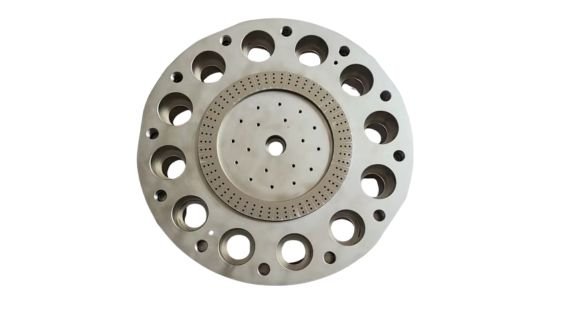Die Plate For PET
| Products: |
PET |
|---|---|
|
Number Of Holes: |
90~2106 |
|
Hole Diameter: |
2.8~3.2mm |
|
Diameter: |
330~700mm |
|
Production Output: |
1000~ 20000 kg/h |
|
MAAG Pelletizer: |
PEARLO |
Cutting-edge PET pelletizing solutions
PET is a thermoplastic polyester with excellent mechanical properties, chemical resistance, transparency and barrier properties. PET is widely used in: food packaging containers, electronics packaging, automotive injection molded parts and optical films.
PET underwater pelletizing process: the melt is kneaded through the extruder and enters the pelletizing system, the melt is extruded from the pelletizing die plate at a temperature of 260~290°C, and is quickly cut off into pellets by rotating the cutter in the cooling water at 60~80°C. The PET pellets are cooled and cured, and arrive at the vibrating screen through the cooling circulating water.
PET underwater pelletizing advantages are obvious: compared with the pull-strip cutting pellet type, high yield; smooth surface of the particles, high transparency, no burrs and no dust; precise temperature control to avoid degradation and oxidation. Difficulties: strict temperature control of cooling circulating water to avoid bad pellet molding; high requirements on the performance and stability of the pelletizing die plate.
Design
PET melt has poor thermal stability and is prone to degradation and carbonization. When PET melt passes through the pelletizing die plate, the retention time needs to be reduced, so that the uniformity and molding effect will be good when PET pellets are molded. We optimize it by design:
Die hole: Unique conical inlet step design to reduce the retention area, prevent dead zone generation, avoid polymer clogging and degradation material accumulation;
Discharge port: symmetrical layout, multi-row design, stabilizing the discharge temperature;
Orifice: L/D ratio (L/D) 5~6 golden ratio, with different viscosities, the melt pressure is increased by more than 50%.


Material Selection
Pelletizing die plate is divided into template and pelletizing belt, need to be resistant to high temperature and corrosion, wear-resistant. PET melt hydrolysis produces acidic substances, has a certain corrosive, generally use stainless steel or carbide.
Pelletizing belt work immersed in water, cutting granules in the process of the possibility of touching the cutter knife, need to be resistant to high temperature, wear and corrosion resistance, the choice of tungsten carbide (tungsten steel) or titanium nitride (TiN) coating. Pelletizing belt and die hole, after processing, through the mirror polishing process, to achieve Ra ≤ 0.1μm, minimize the adhesion of the melt.
Ultra-precision Machining
The size and shape of the die hole needs to be precise, using micron-level electric discharge (EDM) molding technology without mechanical stress to achieve the high precision required. After processing, ultrasonic polishing is used to reduce the surface roughness (Ra≤0.4μm) and minimize logistic sticking.
Surface functionality of pelletizing belts: Pelletizing belts are in contact with the material and need to be highly wear-resistant and have a specific texture to guide the material flow. Using a laser engraving machine, fine textures at the micron level are created by etching technology to control the flow path and direction of the melt.
The core of the pelletizing die plate lies in the precision of the die holes and the surface functionality of the pelletizing belt. After high-precision machining, we ensure that the final result meets the requirements through our inspection equipment.
Coordinate Measuring Machine (CMM): detects the external dimensions of the pelletizing die plate, hole diameter and hole spacing.
Optical projector: detects the shape and arrangement of mold holes.
Electron microscope (SEM): to observe the microscopic morphology of the inner wall of the mold hole and the granulation belt.

Breakthrough Results
We are currently experimenting with nano-coating technology for pelletizing belts. Highly filled PET composites that contain reinforcing components, such as glass fibers, increase wear and reduce the life of the pelletizing die plate. Nanocrystalline coating technology makes the die plate test, life expectancy exceeds 18 months.
A Southeast Asian engineering plastics production line, test nano-coating technology pelletizing die plate, continuous operation hours longer than 6000 hours, PET composite glass fiber pelletizing pass rate exceeded 96%, maintenance cycle is 2 times the traditional equipment.



